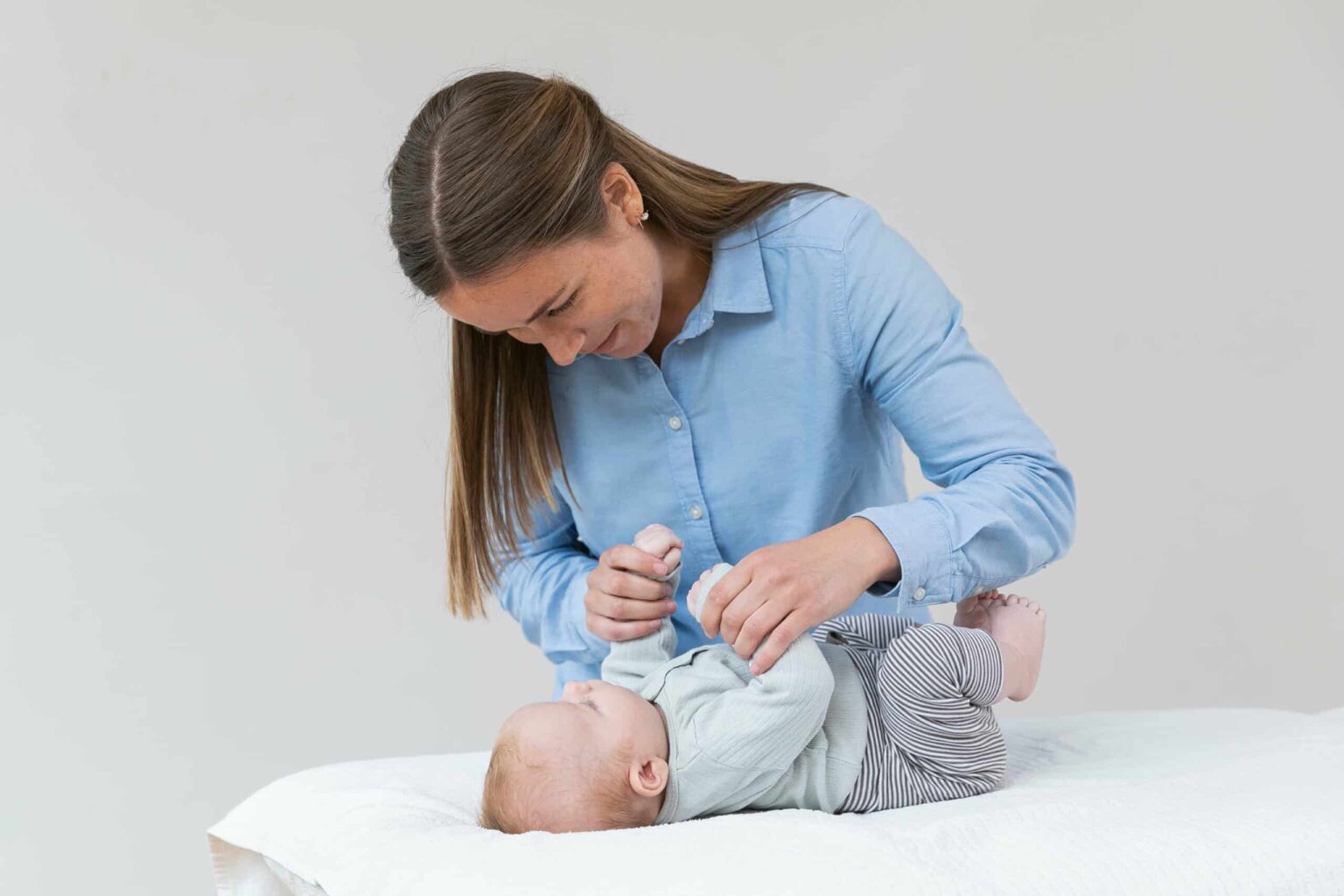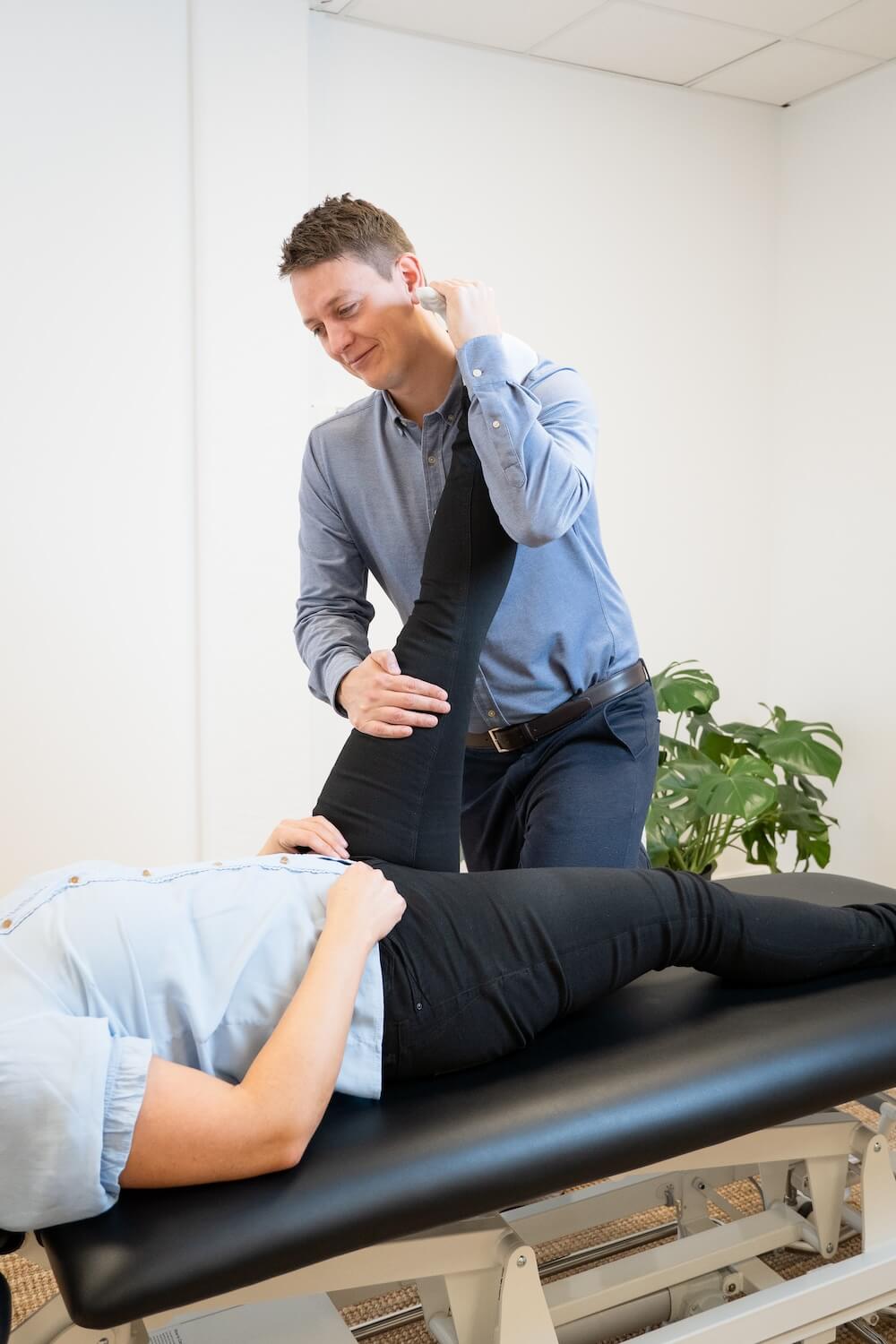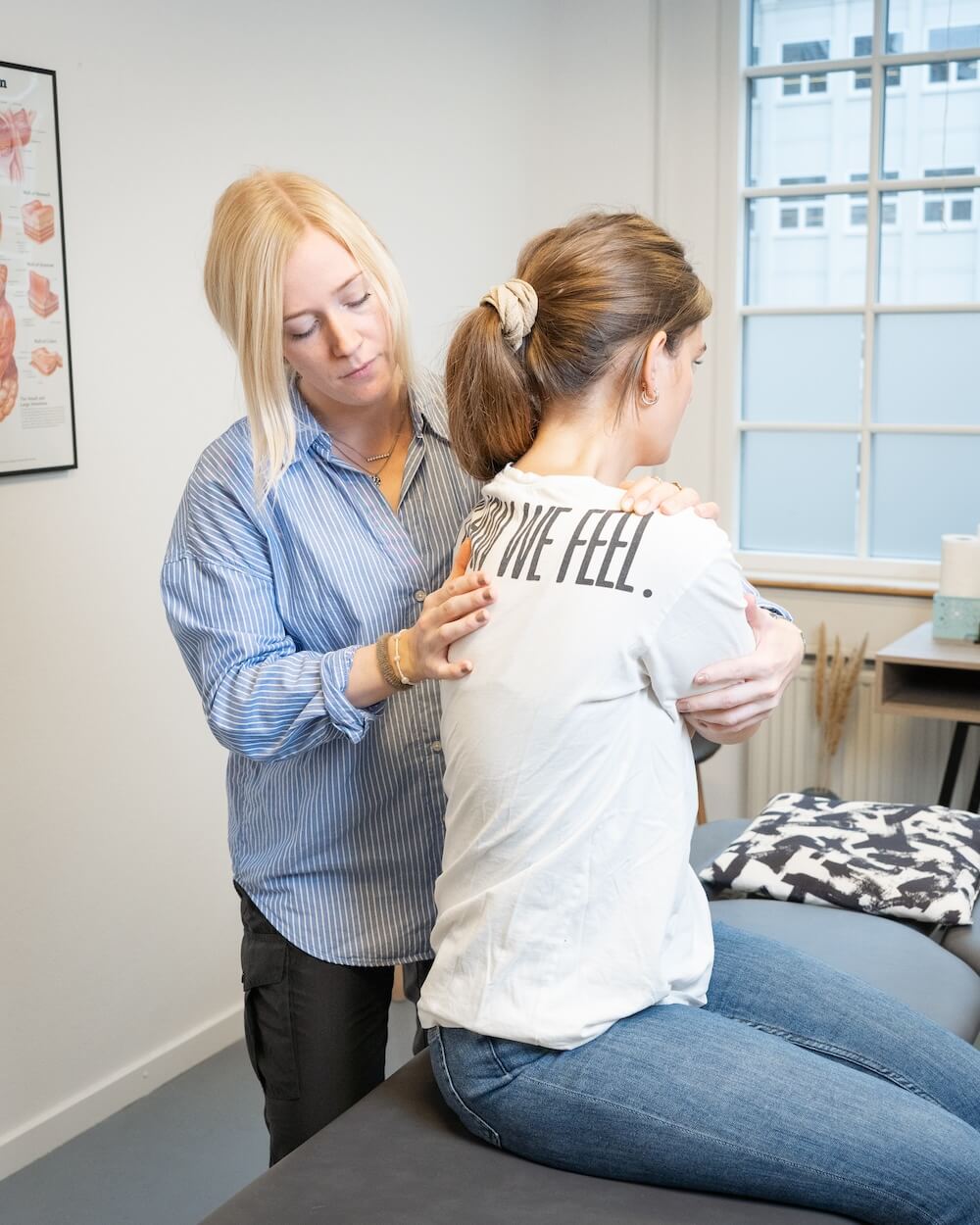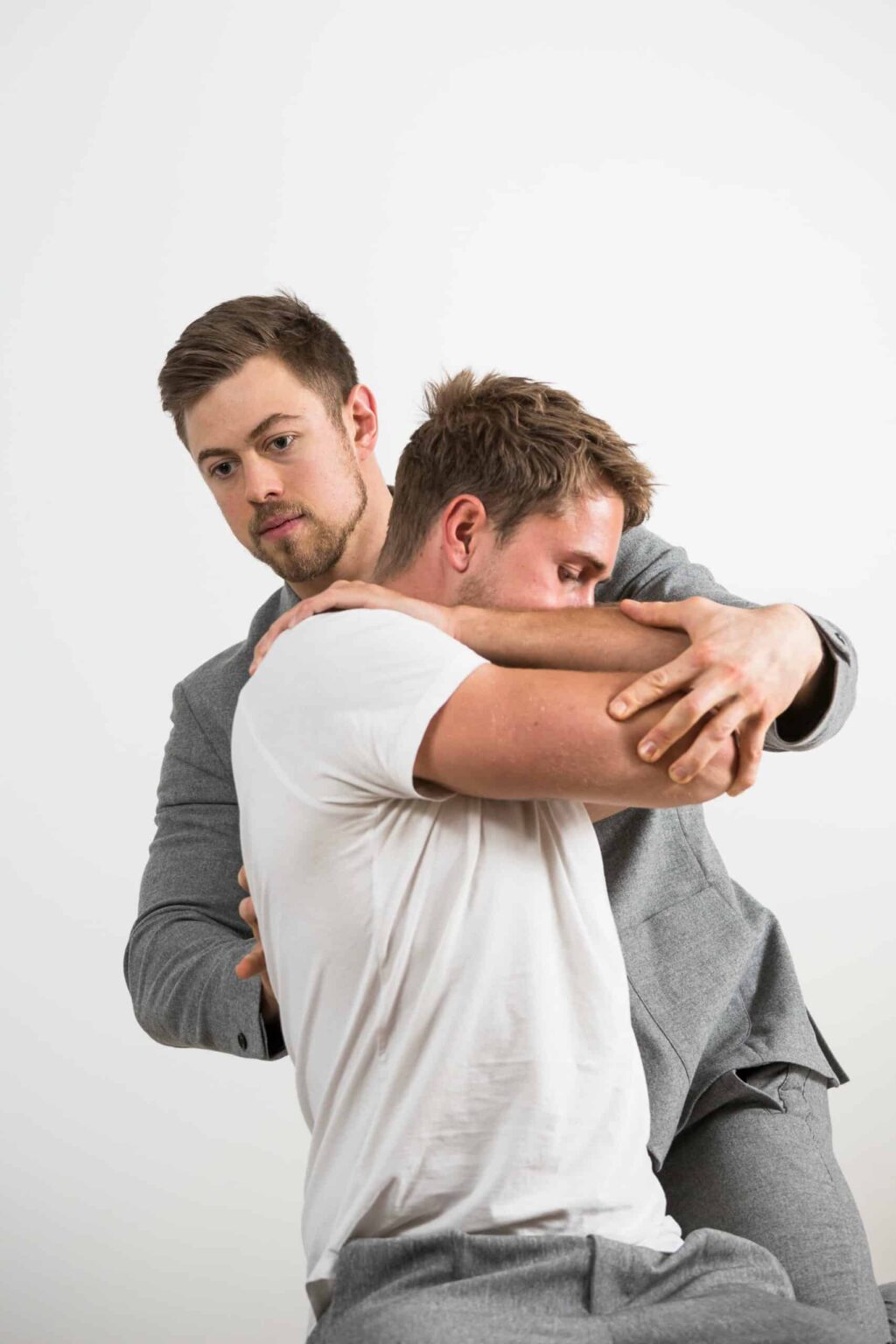We treat
Strains
Learn more about strains and their treatment
What is a strain?
A strain is a condition where pain is experienced in an injured muscle, and depending on the extent of the injury, the pain can extend and affect multiple muscle groups and joints. With a strain, there will often be immediate tenderness or pain when moving the muscle, bearing weight, and touching the area.
Jump to section [Vis]
The definition of a strain
The definition of a strain is primarily described as an injury to multiple muscle fibers at the muscle-tendon and muscle-tendon junctions, including a muscle injury. The cause is often due to the body’s muscles being exposed to greater loads in extreme positions during severe physical stress, typically in connection with sporting activities. The athlete will experience acute reduced movement, soreness and will not be able to continue the activity.
Depending on the incident and the extent of the injury, it will often take 24 hours to assess the degree of muscle damage the athlete has suffered. The diagnosis of strains is based on the patient’s medical history and clinical examination. Imaging can be used as a useful tool to support the prognosis of the injury.
Source: Mayo Clinic

Types of strains
Strains are categorized into ‘direct’ and ‘indirect’ strains, respectively.
The majority of strains occur in situations where there is no contact with other people, categorised as ‘indirect’ strains. These are typically suspected to occur at the muscle-tendon junction, where the tissue is unable to withstand the load applied. Strains typically occur in the eccentric phase, which means the muscle lengthens during a contraction, following an indirect overload, which occurs most often in non-contact sports, and following direct trauma in contact sports. In the case of direct trauma to a muscle, the injury will typically be at the muscle-tendon junction, and in the case of indirect trauma at the end of the muscle-tendon junction.
Prognosis
There is a big difference in the prognosis if the strain has been either directly or indirectly affected by trauma. In direct trauma where an external force is applied to the muscle and external and internal structures are pressed against each other – this is often categorized as mild, moderate or severe strain. In indirect trauma there is no external traumatic force and the main cause of the injury is an eccentric contraction of the muscle. This is often categorized as structural and non-structural injuries, where the former presents a clear anatomical injury, of which non-structural injuries have no obvious anatomical injury.
The most commonly involved muscles and muscle groups are those that contain a high percentage of type II fibers, have a pennate architecture, and cross over two joints, namely the biceps femoris, quadriceps, and medial gastrocnemius. Although the diagnosis is usually clinical, imaging is often recommended to better identify the extent and location of the strain, helping the practitioner assess prognostic factors such as recovery time, return to normal pre-injury activity, and risk of recurrence.
Overview of types of strains
| Types | Subcategories | Expected Tissue Healing |
|---|---|---|
| Strain due to indirect trauma | Non-structural injuries: • Type 1A • Type 1B • Type 2A • Type 2B |
7–14 days |
| Structural injuries: • Type 3A • Type 3B • Type 4A |
*(D): Shorter *(M): Longer *(P): Longest |
|
| Strain due to direct trauma | Grade I: Mild injury with minimal muscle fiber tearing | 2–4 weeks |
| Grade II: Moderate injury with partial muscle fiber tearing | 2–3 months | |
| Grade III: Severe injury with complete muscle fiber rupture | 6–9 months or longer |
*The location of the muscle injury may influence expected healing time — distal (D), mid (M), proximal (P).
Expanding the overview’s subcategories
Non-structural strains:
Type 1A: Due to fatigue due to changes in training protocols, running surfaces, and higher intensities.
Type 1B: Due to excessive and prolonged eccentric contractions.
Type 2A: Is associated with spinal cord problems, often misdiagnosed, which irritate the spinal nerve and alter the tension in the muscle.
Type 2B: An imbalance in neuromuscular control. This occurs when the nerve connection to the agonist muscles is reduced and the agonist muscle is strengthened as compensation.
Structural strains:
Type 3A: A minor muscle injury involving one or more primary fascicles in a secondary bundle.
Type 3B: A moderate muscle injury involving at least one secondary bundle, with less than 50% of the rupture surface.
Type 4A: A subtotal tear involving more than 50% of the fracture surface or a complete avulsion of the muscle involving the muscle tendon or muscle tendon junction.
Source: Muscle Injuries: A Brief Guide to Classification and Management

Symptoms and signs of strains
When you get a strain, symptoms can vary greatly depending on the context and location of the strain, ranging from mild soreness to severe pain.
Symptoms of a strain are often:
- Pain on or around the affected area
- Swelling
- Discoloration
- Impaired functional ability
- Tenderness
Signs of a strain due to direct trauma (Grades I-III) are immediate pain and symptoms increase with the development and size of the hematoma (blood collection). There is immediate impairment of function and the injured person must take a break from their usual activities. In non-structural sprains, symptoms will often be tenderness, a feeling of heaviness and stiffness in the muscles, which may be aggravated by activity.
Signs of a strain from indirect trauma or mild types of strain (Type 1A) are typically muscle soreness a few hours after the activity, and when touched the entire muscle feels stiff. In Type 2B, muscle cramps may occur, which are immediately relieved by stretching.
A minor structural injury (Type 3A) is characterized by sharp pain, provoked by a specific movement. The pain is deeply localized, and light touch can provoke familiar symptoms, and in these cases one may have a sensation of a “pop”.
In a partially moderate injury (Type 3B), acute sharp pain is experienced, triggered by a specific movement. Here, a “pop” may also be experienced immediately followed by deep localized pain and you may lose the ability to stand due to pain. Clear symptoms when touched and then it is possible to see swelling and blood accumulation a few days later.
Complete tears (Type 4A) occur with severe pain aggravated by specific movement; there will be a “pop” and immediate loss of function. Touching worsens known symptoms and swelling and hematoma develop early.
First aid and treatment of strains
Right after you have a strain, the following protocol should be initiated.
Peace and Love is the protocol for treating acute strains and your first aid for a muscle injury (it was previously known as the RICE and POLICE protocols, but recent studies from 2019 indicate a shift in the management of muscle injuries).
- Protection: protection for the first 1-3 days to reduce bleeding and reduce the risk of further injury and deterioration. Minimize prolonged periods of rest, as this reduces muscle strength. Let your pain guide you as to whether you should protect or gently and gradually strain your muscles.
- Elevate: Raise your leg or arm above heart level to promote interstitial circulation out of the injured tissue.
- Avoid: Avoid anti-inflammatory medication as it can have a long-term negative effect on tissue healing. Cold therapy can be used for pain relief, but avoid using cold after the first 1-3 days as it can have a negative effect on tissue healing and texture.
- Compress: Compression to limit intra-articular fluid accumulation and tissue bleeding using tape or bandage, the mobility of the joint must not be restricted because of this.
- Educate: Education through pain management, progressive rehabilitation and manual therapy to optimize healing of tissue damage and promote return to everyday activities.
- Load: After the first few days, the tissue needs to be loaded. An active approach with supervised exercise therapy from a competent therapist will promote tissue remodeling and increase tolerance for both muscles and tendons.
- Optimism: Optimism plays an important role through conversation, patient education and pain management in connection with the patient’s treatment process. It is important to overstate expectations, verbalize fear of movement and catastrophic thoughts in the event of lack of progress.
- Vascularisation: Vascularisation through cardiovascular training which should be maintained at a level without provoking known symptoms.
- Exercise: Exercise has long been scientifically supported as an important factor in the treatment of muscle and joint injuries. It helps minimize the risk of recurring injuries.

Prevention of strains
Once a muscle or muscle group has been strained, it is more vulnerable to re-injury. It is therefore important that the therapist helps the patient understand the importance of regular treatment and regular exercise routines before the patient is ready to return to everyday activities or sports.
A treatment course focuses on reducing pain through manual treatment and supervised rehabilitation, and it is important that the course does not stop too early.
Even if the pain has reduced and you feel ready to resume your activity, you should ask or seek advice from your therapist regarding whether the injury is ready for greater strain despite less pain.
Unfortunately, it is often seen that the patient starts his usual activity too early, increasing the risk of relapse and thus a significantly longer treatment course. Prevention of strains is a combination of manual treatment to promote the natural healing of the tissue and a progressive rehabilitation program. Here, eccentric training is a good method to increase the muscle’s ability to absorb loads. It also reduces muscle stiffness and viscoelasticity in the muscle-tendon transition.
Rehabilitation after strains
First phase: Acute treatment in the first 2-3 days after the injury may include cold therapy combined with moderate exercise (active and passive stretching), as tolerated. This is where the Peace and Love protocol is initiated. The injured muscle should be protected from excessive strain, which can slow the healing process. Rest is necessary to reduce metabolic demands. Compression limits swelling, thereby helping to control inflammation and promote homeostasis.
Second phase: After the acute treatment (3 to 7 days after trauma), gentle muscle training can be initiated, either passive, assisted, or active. Neuromuscular training can help promote neural structures and increase local flexibility of the muscle. Isometric training can also promote muscle recovery; concentric and eccentric exercises can be started when moderate isometric training can be performed without pain. Initially, these exercises should be performed without resistance, and the load should be gradually increased.
Third phase: Functional rehabilitation and general rehabilitation aimed at normal activity. This is a sport-specific rehabilitation phase that involves the metabolic system, specific and individualized training protocols, cardio and strength training. Including complex multi-task exercises such as cognitive tasks.
Fourth Phase: Specific Rehabilitation. It is now possible to begin high-intensity training protocols based on strength and sport-specific abilities. Plyometric and ballistic exercises are initiated. At the end of this phase, the athlete should be able to repeat many sets of the sport-specific movements that caused the traumatic injury.
Fifth phase: Return to normal activity or competition. There can be a gradual return to full activity, but it is important to continue following the rehabilitation protocol to prevent the occurrence of new injury.
We also offer rehabilitation for everything from ankles and knees to neck and shoulders – and everything in between.

Long-term effects of strains
Strains can lead to an increased risk of recurring injuries in sports and other physical activities. Long-term effects of strains can cause symptoms such as weakness and pain in the tissue.
If you have had repeated strains, the damaged tissue will be more chronically affected by scar tissue formation.
It changes structural conditions in the muscle which can cause persistent symptoms and morphological abnormalities in the tissue, with the result that return to usual activity or sport is postponed.
This is a consequence of changes in the muscle, such as motor unit rearrangement and denervation. In an attempt to replace these muscle fibers, although the remaining motor units will grow in size and number, their ability to fine-tune force intensity, and hence muscle strength, will be lower.
Strains in various sports
Strains are one of the most common injuries in sports, accounting for 55% of all acute sports injuries.
Football is one of the most popular sports in the world, and in professional football, strains account for 31% of all injuries, with 37% of players missing training and matches during a season. The most affected muscle groups are the hamstrings (37%), adductors (23%), quadriceps (19%), and calves (13%). Non-structural injuries are the most common, accounting for 70% of all muscle injuries among football players. Although muscle injuries cannot be diagnosed immediately, they cause more than 50% of days of absence from sports activity and training. If the extent of the injury continues to be unrecognized, they can become structural injuries.
Padel and tennis players are also exposed to many repetitions with high loads and here strains account for 84% of all acute injuries such as strains in the groin, thigh, calf muscle, abdominal muscles and back. The most frequent regions for muscle injuries are the legs 41.7%, the arms 25% and 16.7% in the abdominal and back region.
Among other sports, the incidence of muscle injuries is 18% in basketball, 16% in running, and 11% in rugby. In these sports, the hamstrings, forelegs, and adductors are most frequently affected.
Source: National Library of Medicine

Myths and misconceptions about strains
Cold or heat
In general, cold therapy is more appropriate for new injuries, such as strains, while heat therapy is typically better for treating chronic conditions.
Cold: Cold is best for acute injuries, while heat is a better option for chronic injuries. Placing an ice pack on an acute injury helps reduce pain and swelling immediately because the cold causes blood vessels to constrict. This reduces internal bleeding at the original site of the injury.
Heat: Heat is ideal for treating chronic injuries that do not involve inflammation or swelling. It helps reduce the pain associated with stiff and sore muscles and joints. Placing a heat pack on your affected muscles before you start exercising can reduce the pain you are currently feeling and prevent your pain from developing. Heat stimulates blood flow and increases the elasticity of the connective tissue in your joints. In addition, heat can stop a muscle spasm and cause the muscles to relax. It is important to avoid applying heat to acute injuries with symptoms of inflammation. The reason for this is that heat raises your skin temperature and increases your circulation.
Misunderstandings: There is often debate among healthcare professionals working with athletes about how to best manage an acute injury when it comes to cold and heat. The evidence is based on the physiological mechanisms of action in acute inflammation and chronic inflammation. Inflammation is the foundation of healing, but must be controlled. Control can be achieved by applying cold to the injured tissue for a limited period of time to reduce temperature, metabolic stress and circulation. It also works by reducing pain signals in the area.
About 72 hours after an acute injury, cold should be replaced with heat to stimulate blood flow and promote the elasticity of connective tissue around the injury.
This will make it easier to perform mobility exercises and move muscles and joints.
New research findings on strains
Recent studies show that the most frequent muscle strain injuries and strains occur in the lower extremities, which are very common in sports and activities with multiple changes of direction at high intensity, such as football, handball, tennis and padel tennis.
Among the most common injuries are hamstring and groin injuries, which can be reduced by 40% to 65% with specific training interventions. It can be mentioned that eccentric strength training exercises can create the greatest and fastest effect on muscle tissue healing and promote a return to normal activity. This type of training intervention has also shown a lower risk of recurrent injuries compared to conventional training exercises. The same type of strength training can improve sequelae after strains and optimize muscle function even many years after a strain injury, even with only short-term training interventions. However, it does not seem to affect the overall structural abnormalities in the area of scar tissue.
Source: Cleveland Clinic

Strains and aging: What you need to know
As you get older, the risk of muscle injuries increases. This is a consequence of aging-related changes in muscle tissue, such as changes in morphological properties and scar tissue formation. Previous injuries also have a contributing factor, but lifestyle factors play a special role in preventing muscle and tendon problems in the body.
Good eating habits provide energy for the body so that exercise can be practiced, regular exercise and movement promotes circulation and can help with stable blood sugar. A good night’s sleep will ensure optimal recovery so that your muscle injuries can heal faster. The key to recovery and prevention of muscle injuries is to get control of inflammation, which can often be managed through a good and healthy lifestyle.
How diet and nutrition affect the healing of strains
In general, it makes good sense to have a healthy and varied diet, including good eating habits. This provides a better basis for the body to produce, distribute and use the energy that is put into the mouth.
When muscle damage occurs, the body needs extra energy to optimize the healing of the damaged tissue. This is often seen as a balance between the building processes, “muscle protein synthesis”, and the breaking down processes, “muscle breakdown”. Muscle protein synthesis must be greater than breakdown – otherwise the body will have difficulty healing the damaged tissue.
During inactivity, the rate of protein synthesis and muscle building is reduced, which means that you should have an increased intake of protein to meet the same metabolic response – around 2.0 grams per kilogram of body weight.
To optimize the muscle building phase, the diet should have protein sources with essential amino acids and you can take supplements to promote metabolism in relation to rebuilding new muscle tissue, and at the same time you should choose good Omega-3 fatty acids which create strong anti-inflammatory and immune-boosting properties. This helps to control inflammation while promoting natural healing.
If you haven’t had enough protein during the day, it may be a good idea to consume protein sources close to bedtime, as sufficient protein in the body during sleep is important for muscle rebuilding. Diet and nutrition play an important and actually crucial role in the healing of muscle injuries and strains.
Source: Webber Nutrition

Often related injuries

Side stitch

Hypermobility in babies and children

Muscle tension or imbalances in babies and children

Cramps

Strains

Fibromyalgia

